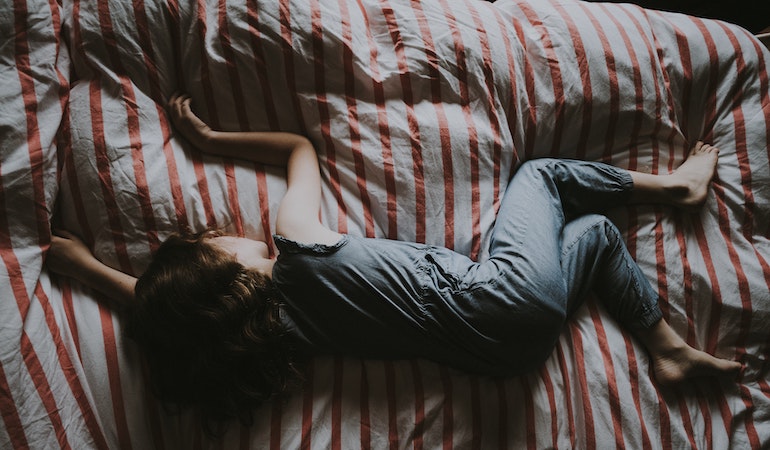Most of the time, when a parent mentions that some undesirable behavior is going on with their young child, it has something to do with one of the child’s three basic physical needs, and if they are met and stable, or not. These are sleeping, eating, and eliminating – and chief among them is sleep.
Sleep is undervalued in our culture and underappreciated as the greatest gift you can give your children for a successful day and ultimately education too.
As parents, we know that our children are better and happier when they get a good night’s sleep, but you might be surprised at how much sleep children really need. The American Academy of Pediatrics recently released guidance for how much various age groups should regularly sleep during a 24-hour period for optimal health. It’s a lot:
- Ages 4-12 months: 12-16 hours (including naps)
- Ages 1-2 years: 11-14 hours (including naps)
- Ages 3-5 years: 10-13 hours (including naps)
- Naps typically taper off by age 4
- Age 6-12 years: 9-12 hours
- Age 13-18 years: 8-10 hours
A journal study published by the Pediatric Clinics of North America confirmed lack of sleep for children is one of the greatest factors in any manner of negative outcomes, including attention and behavior difficulties, learning problems, and even being accident-prone.
If you’re having any challenges with helping your children get the sleep they need, I have some recommendations based on my years as a Montessori Guide and parent.
Lessons from Dr. Montessori
One of the most important tools Dr. Montessori used in crafting her method of education was observation. The Montessori method is based on scientific observation and trial-and-error adjustments to the environment to promote the best outcomes for children.
So use that trick too!
Observe your child for the challenges to their night-time routine, note them down, and see how you can change things for them, the set-up of the routine, the space, and the timing of it all, too. Look out for your own child’s signals and sleep readiness window.
It is the rare child who cheerfully heads to bed without assistance or resistance. For a child, sleep is a form of separation, and so to help them manage this profound moment of individuation, we can use routine and ritual to provide comfort during this nightly event.
In learning about sleep and observing children over the years it has become evident that there is only a small window of time when a child slows down long enough to settle for rest before their body gets a boost of adrenaline that revs them up again. Remember that if children resist rules or insist on staying up, they’re not being naughty or intentionally disrespectful. Instead, they’re responding to an evolutionary adaptation to stay awake when they’re over-tired, which is why it can get harder to put them down the more exhausted they are (and we are)!
Routine and ritual allow for predictability, which is both reassuring and psychologically safe. When children feel this safety and are given choices within reasonable limits, they are set up for more success.
And, as we all know, the inverse is also true. Adults can scaffold their child’s transition to sleep by offering an evening that is both unsurprising and soothing and really sets the tone for relaxation, and rest.
Some common and essential elements of an evening routine to promote good sleep include:
- Consistent meal time. Working schedules and life can make it difficult to eat at the same time each evening, but it is worth your while! Eating at 5:30 or 6:00 each night will satiate your child and signal that the bedtime routine has begun!
- Calm (even boring…) environment. Dim the lights. Turn off the screens. Light a candle. We can help children move toward sleep by signaling that the excitement of the day is coming to a graceful close.
- Uninterrupted time. A sustained focus on the child helps them separate. Silence your phone. Turn off the screens. If someone plans to come home right in the middle of bedtime, ask them to come into the house quietly and avoid the room where the sleep routine has begun. It’s hard to stay away, but it helps the child stay on task, calm, and prepared to wind down and eventually independently fall asleep.
- Routine. Decide on a manageable routine and stick to it. Allow your child to select a book of choice (brief books are ideal if you are short on time)) and then complete your goodbye ritual. For example, a good night routine that worked for me and my family was that the adult would read one short book, sing three songs in the same order, give two kisses –- one for each cheek– and then depart.
Of course, ritual and routine aren’t panaceas. Most children will, at some point (or at many of them…) still want to stay both awake and with you. You are so appealing! The goal for us parents is to respond calmly and consistently to any protests by bringing the child back to their room. A loving, understanding, but confident and firm response to protests will eventually confirm to your child that the day is over.
When my children were young, my favorite line was, “There’s never enough time with you, but that’s why they invented tomorrow!” Then I would give kisses and hugs and go. If they got out of bed and came looking for them I would simply say, “It’s bedtime, back to bed.”
Say it once and then be quiet the rest of the time. The lack of words may even be more powerful. Keep bringing the child back to bed and repeat until they know you are consistent and won’t let them stay up longer, or sleep in your bed.
It’s hard, but it also works!
Baths, Beds, and Best Wishes
Some children find a bath before bed to be calming; others get amped up. Know your child and respond accordingly. No matter what, be sure to stay attentive and to limit the stimulation. If you choose to bathe your child before bedtime, do so calmly and peacefully.
I always encourage parents to include some choice in the bedtime routine so children feel some control and autonomy – two essential elements of feeling included in the process. Keep the choice within reasonable options such as which pair of pajamas to wear or which toothbrush to use.
For us parents, though, choice can feel overwhelming. Case in point: what type of bed? Dr. Montessori suggested a floor bed – large, low bedding for babies and toddlers that allow free movement and uninterrupted views of their environment in order to prepare them for independent sleep.
Other families choose cribs for any number of good reasons. If you opt for one, be sure that by your child’s first birthday, the crib mattress is on the lowest setting to prevent your child from climbing out and falling or ensure that your child is transitioned to being able to get in and out of their bed independently, another important milestone to prepare for. Beds that are convertible or that have a toddler rail addition are ideal. Ensure that the bed is as low to the ground as possible.
Regardless of your choice, it’s important to think about the thickness of the mattress and to ensure that the bedding is approved to prevent SIDS.
It’s also essential that you childproof the room if your child is on the go. Ensure that there is an appropriate child gate in front of their bedroom – one that can’t be climbed – that all electrical sockets are covered, and that all cords for electronics and drapes are out of reach.
To reduce temptations and distractions, limit the toys in the bedroom so that it functions as a sleeping space. Also, keep an eye on the room temperature and find your child’s preferences.
A few final notes that might ease the transition to sleep:
- Ahead of Day-Light Savings, consider adjusting your child’s bedtime in 15-minute increments four days in advance of daylight savings days to take some of the edge off of the process of adjusting to a new time.
- Once you’ve said goodnight, be more boring downstairs. Speak softly. Try to keep screens off or at least quiet to limit temptations and distractions.
- Avoid too much water before bedtime. One typical reason sleeping children wake up is that they have full bladders. Ideally, try to taper off liquids after dinner.
- Get your own good sleep! If you get a full night’s rest, you can enjoy your child more, and if your child gets a full night’s rest, they will enjoy everything more. Young children simply don’t have the coping mechanisms to make it through their day without sleep.
Helping your child develop healthy sleep patterns can be challenging, so be kind to yourself. There will be setbacks. These years are precious and fleeting, so put in your best effort, experiment, and enjoy!

Siri Panday is Marin Montessori School’s Director of Education for Toddler and Primary. For 11 years, she served as a lead guide at AMI schools, six years as an inaugural Assistant Head of School in New York City, and two years consulting for Montessori schools and families. She is an AMI Primary Consultant, visiting other AMI schools to evaluate and support them in their teaching practices. Siri has AMI diplomas for both Assistance-to-Infancy (Toddler) and Casa dei Bambini (Primary), a master’s degree in Montessori education and a second master’s in special education. A particular career highlight was living and working in Nepal for six months where she assisted with starting a Montessori school in Kathmandu. More recently, she had the opportunity to participate in a special education classroom assisting children on the spectrum with reaching academic and social goals. Family life is the focus of her personal time. Observing and supporting her daughters as they grow is her greatest joy.





